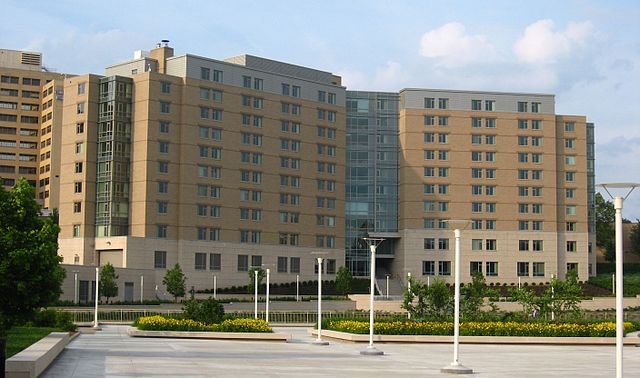Upperclass students advise on off versus on-campus living
Image via TheZachMorrisExperience, Wikimedia Commons
Panther Hall on Pitt’s upper campus.
November 10, 2021
To dorm or not to dorm? The age-old debate of on-campus versus off-campus housing is currently waging war in the minds of the largest first-year class to ever attend Pitt.
There are 4,674 first-years, 2,422 sophomores, 741 juniors and 202 seniors living on campus this semester, with the rest assumed to be living off campus, according to a University spokesperson. When students make the decision between on- and off-campus housing, safety, cost and location all play a role.
The process of finding a place to live off campus begins early, which Julia Lombardi said is an added stress.
“It was a little bit stressful, especially because we were told that we sort of had to have everything figured out by early November,” Lombardi, a sophomore psychology major, said.
Because the hunt for an off-campus house begins so early, first-years often face the challenge of deciding who to room with.
Yasmeen Gauri, a junior psychology and religious studies double major who currently lives in South Oakland, said the process of finding off-campus housing is stressful because first-years may not actually know their friends well before signing a lease with them.
“As a freshman I barely knew my friends at that point and it’s like, who do I want to live with,” Gauri said.
Isabella Kitchen, a junior environmental engineering major, said applying for on-campus housing is not stressful. She said the process does not begin until the spring semester, but includes weeks to months of waiting for an assignment.
“It starts during spring semester for the next year, but we don’t hear back about our assignments until July, so it’s a lot of waiting to figure out what’s going on,” Kitchen said.
Pitt guarantees students housing through their junior year, so those who want to live on campus don’t have to worry about finding a place to live.
The University’s Institutional Master Plan, a 10-year development plan which the City approved this summer, includes projects to add more than 1,000 beds in the next few years in order to accommodate the increase of class sizes, according to a University spokesperson.
Part of the plan includes a housing development on the upper campus hillside, which will add approximately 600 beds. The plan also includes redeveloping the fraternity complex on upper campus, Forbes-Craig apartments and Bouquet Gardens, as well as changing the Litchfield Towers Plaza.
When considering whether to live off or on campus, the price of rent versus the price to live on campus also impacts students’ decisions. The price of living off campus varies based on location and quality of a home or apartment.
Lombardi said she doesn’t feel like she overpays for her off-campus house, but added that she shares a room in order to get the cost so low.
For on-campus housing, the cost is divided by semester rather than by month. A University spokesperson said on-campus housing costs an average of $3,782 per semester, with cheaper, dorm-style upperclass housing requiring meal plans.
The issue of safety also comes up for many students when deciding between on- and off-campus housing.
Gauri said while she does not necessarily think about safety often, she definitely isn’t completely at ease either.
“I don’t really worry about [safety] I guess, but in terms of how safe I think I actually am, I’m probably not nearly as safe as I am at home,” Gauri said.
According to crime data from the Pitt police, Oakland saw an average of about 1,100 incidents reported per 100,000 full-time equivalent students. The rate hit a low in 2020, with 642 incidents per 100,000 full-time equivalent students.
Between 24/7 security guards and keyless entry, Kitchen said she feels safe in her on-campus room in Panther Hall.
But with increased security comes decreased freedom. Even as upperclassmen, most students living in upperclassmen dorms still have to check people in at the security desk. Gauri said the regulations in dorms, such as having to sign guests in, is part of the reason she moved off campus.
Students said the proximity to campus and immersion in the campus community are also factors in determining where to live. All on-campus housing is within walking distance to the Cathedral of Learning, making them somewhat centrally located.
Kitchen said this proximity to campus and therefore proximity to other students makes finding friends easier.
“It’s easier to meet people because you live down the hall from them,” Kitchen said. “I think if I were off campus I wouldn’t actively try to make friends.”
But there are no guarantees that off-campus houses are located close to the University. Some apartments or houses require a 20-minute walk or a bus ride.
Lombardi said she does feel a bit isolated living off campus.
Gauri said students planning to move off campus should prepare for a drop in quality compared to Pitt dorms.
“Prepare yourself to downgrade a little bit from what you’re used to if you’re going to move into South Oakland,” Gauri said.
While finding housing is a stressful endeavor, Lombardi said other students should not rush through it without thinking.
“Don’t make snap decisions,” Lombardi said.



